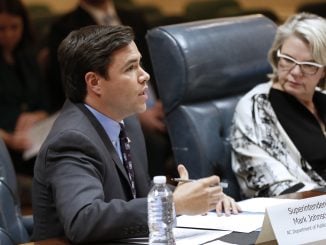RALEIGH — At the June 3 State Board of Education meeting, N.C. Department of Health and Human Services (NCDHHS) officials told board members masks were probably not going to be coming off students anytime soon.
Gov. Roy Cooper’s Executive Order 215, which lifts some restrictions but keeps the statewide mask mandate for K-12 schools in place via the StrongSchoolsNC toolkit, will expire June 11 — just as most public schools are letting out for summer. It is unclear if he will allow the order to expire.
Dr. Betsy Tilson, NCDHHS state health director and chief medical officer, said that throughout the pandemic NCDHHS had been focusing on “four key metrics” for making decisions. Those metrics include the percentage of people coming to emergency rooms with COVID-like illness, statewide COVID hospitalization rates, daily case rates and positive tests as a percent of total tests.
Yet, in order for masks to come off kids in schools, Tilson cited a different set of criteria. She said COVID-19 transmission rates need to be low, but she did not specify a rate level or if she meant a statewide or local rate. She also said there is a need for more research on COVID-19’s impact on children before finally tying removing masks in schools to vaccination status — specifically the vaccine eligibility for children 12 and under.
Tilson and NCDHHS deputy secretary Susan Gale-Perry’s presentation cited around 150,000 (19%) 12 to 17-year-olds in North Carolina have been vaccinated so far. The Associated Press reported that as of Friday, June 4, North Carolina returned over 1.2 million doses to the federal government, the state has a surplus of almost 2.4 million unused doses and the Cooper administration turned down an additional 2.4 million federally allocated doses.
According to both Tilson and the presentation, children being “largely unvaccinated” is a part of why NC K-12 school children are still being required to wear a mask indoors.
“The rationale is… as we just showed on those slides… that the vast majority of the people, of those children in those settings, are not vaccinated, because there is no vaccine authorized for them,” said Tilson. “So, the large portion of those people are not vaccinated.”
During the discussion of NCDHHS’ presentation, SBOE member Amy White said they are receiving a lot of questions about continued masking for children. She said she had looked at the state’s COVID dashboard and found that there had been a few deaths for children linked to COVID, but that the dashboard reported a “zero percent death rate” for children up to the age of 17 in the state.
White also noted that May’s data showed there were less than 50 children that have been infected with the virus. She then asked Tilson if they were taking into consideration “the risk/harm ratio of wearing masks for an extended period of time,” and cited increasing reports of children having shortness of breath during activities due to wearing a mask.
White reiterated statements made by Tilson and Gale-Perry in the past about children having the lowest rates of infection, the lowest rate of spread and the lowest death rate.
“What exactly are the metrics that you are using that would suggest when we can unmask children?” White asked Tilson.
While Tilson agreed with White that children have a lower infection and spread rates, she said children were possibly being undercounted in testing, because they don’t have “acute cases” like adults. She also agreed on the aspect of hospitalizations but then shifted into talking about “long-term” effects of the virus and inflammatory syndrome associated with child COVID infections. Tilson said they needed more data on the “long-term effects” of COVID on children and vaccine access for younger children.
During her response to White, Tilson also said, “We have that really great data that masks prevent the spread.” That reference is likely part of the report by the ABC Science Collaborative at the May meeting of the state board of education at which state Superintendent Catherine Truitt asked what metrics needed to be in place to unmask children and, like White in June, Truitt did not receive a clear answer.
“I didn’t know how I could have been more clear, and the answer was basically, we don’t know yet,” Truitt told North State Journal in an interview. Truitt also said she would not support requiring vaccinations to get rid of masks.
“Let me be clear. I am never going to advocate that children under 12 need to be vaccinated in order for the mask mandate to come off,” said Truitt.
June 2 was the first COVID briefing that the press had been allowed to attend in-person since March 20, 2020. At that briefing, NCDHHS Secretary Mandy Cohen was asked whether or not K-12 school children will be required to continue wearing masks when school resumes in the fall.
Cohen said K-12 student masking “will continue until the guidance changes from the CDC.”
States like New York, where the outbreak of COVID was most severe, have already indicated students will not have to wear a mask to school this fall. In neighboring Tennessee, Gov. Bill Lee signed an order in April removing the authority for localities to require masks and letting school districts choose whether or not to require one. In South Carolina, which had no comprehensive state mask requirement have removed mask requirements for K-12 students in early May.
Cohen also said that a “vast majority” of students are unvaccinated and that the CDC continues to recommend that all people, including children, who are unvaccinated need to continue wearing a mask indoors.
“I think we will need to see as the summer moves along,” said Cohen. “It may be possible that vaccinations will be available for younger students.” She added that vaccines for young children might be available “late into the fall.”



